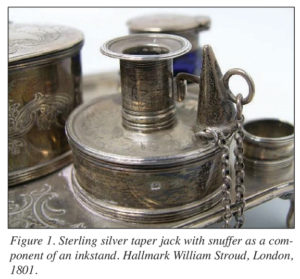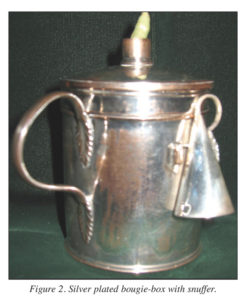 By Jack HT Chang, MD
By Jack HT Chang, MD Prior to the advent of sealed envelopes, confidentiality of missives was provided by folding the letter sheet multiple times than applying melted wax to an edge. A personal seal was then impressed upon the wax. Any tampering would break the wax seal which could not be repaired. The sealing wax was generally in the form of a stick which was melted by a candle. By the 17th century, the candle used to melt the wax had its own holder. There are four forms of candle holders with individual elaborations. Until the third quarter of the 18th century such candle receptacles or taper jacks were usually unpaired miniature candlesticks approximately 10 cm in height. As these were used for correspondence, small taper candle holders were commonly found as a component of inkstands (figure 1). The shorter taper jacks with a plate may have a handle as well as a conical snuffer attached by a chain. Over the ensuing half century three additional forms developed. The bougie-boxes were cylindrical containers with a short spout on the cap (figure 2). The ribbon candle was coiled in the container exiting through the spout. These were particularly advantageous for use during travel. Some were quite decorative with perforated walls and colored glass. The wax jacks were of two forms. In the first, the ribbon candle was vertically or horizontally wrapped around the stem or a bar, respectively, with its tip exiting through a perforation (figure 3, 4). In a second form, the tip of the candle was held in place by a spring plate (figure 5). This had the advantage of catching any dripping from the candle.
 Sterling silver and silver plate were most common although gold, brass, pewter, and iron were also used. These devices were employed for other purposes as tobacco lighters or if adapted with a glass shield, as a small chamber lamp.
Sterling silver and silver plate were most common although gold, brass, pewter, and iron were also used. These devices were employed for other purposes as tobacco lighters or if adapted with a glass shield, as a small chamber lamp. Interestingly, taper jacks, bougie-boxes and wax jacks are not in great demand by collectors. This is rather puzzling as they represent a unique article and are esthetically quite pleasing. Modern forms are easily distinguished and there is little financial incentive for forgeries. Cost of silver plated pieces range in the hundreds and sterling silver examples near a thousand dollars. As with any antique, price is greatly influenced by date, maker, esthetics and provenance. For further reading: Charles R Beard “Taper-sticks. The Wright Bemrose Collection” in The Connossieur, November 1931.
















Follow Us